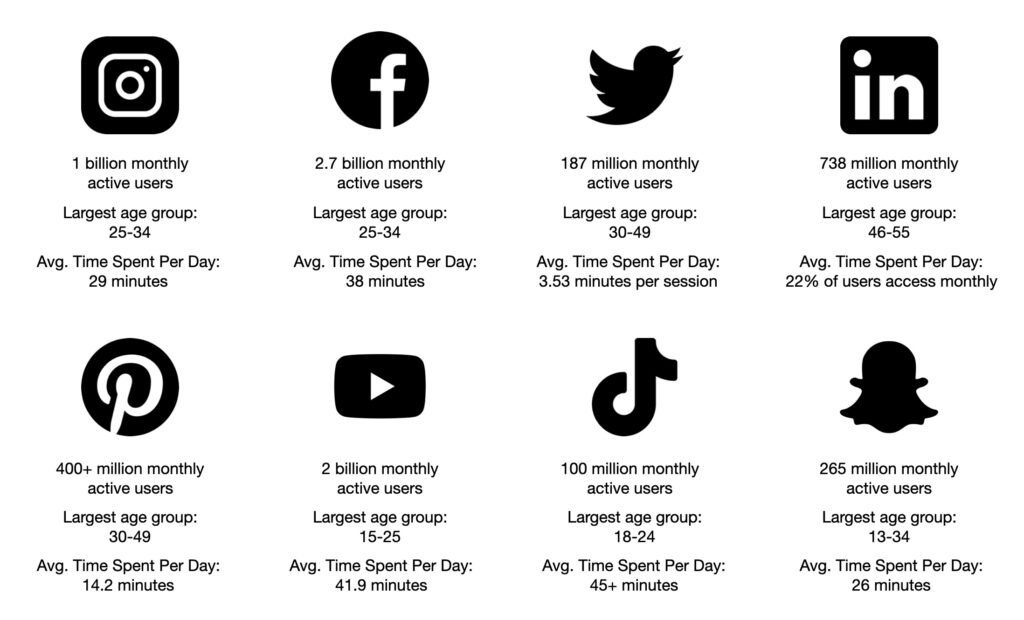Why is social media important in the new business environment?
As we continue to expand the digital environment and move away from traditional advertising platforms, social media has quickly become one of the strongest assets for businesses looking to promote their products and/or services. Users are 57.5% more likely to buy from a brand that they follow on social media making it a great platform to engage with your prospective customers. As widely used as social media platforms have become, it makes for many great opportunities to get your business in front of your target audiences through the use of both organic and paid social advertising.
At this time, there are a few main platforms that make up the popular social media environment. A few of these well-known and used platforms include Facebook, Instagram, Twitter, LinkedIn, TikTok, Snapchat, and Pinterest. These different platforms can vary based on types of content users can share, however, they all have one thing in common – they allow their users to connect, communicate and collaborate with others. As of now, over 4.2 billion people are active on at least one social channel allowing for businesses to capitalize on the positive connections they can make with their potential customers on those platforms. Whether you’re new to the idea of social media or are seeking to improve your current presence, we’re here to help you put your best foot forward when it comes to social media advertising.
What does it mean to advertise on social media?
Although anyone can have an organic social media presence, advertising on social media means that a brand is running paid ad campaigns to reach targeted audiences. Businesses and advertisers can promote their products and encourage sales easily via the channels that their prospective customers frequently use. How is this type of advertising different from traditional advertising efforts such as television or radio ads? It all comes down to targeting. Social media advertising allows businesses to target and directly connect with their ideal customers based on a number of factors about said customers. Based on their interests or geographic location, businesses can place their advertisements in front of interested eyes – making social media the prime platform for advertising in today’s digital environment.
How do you know which platform is best for your business?
Every business is different which is why it is important to compile your own demographic information for all social media platforms and use it to help gauge where your audience spends most of their time online. You can use different social channels to reach different audiences or meet different goals your business may have. In fact, average users have around 8 different social media accounts which allows room for your business to share the wealth and develop a presence on a variety of platforms.
There are always some basic statistics collected by various platforms as well which tell us a bit about their average users:
Establish a social media strategy
Know your audience
Don’t make assumptions about where your audience spends their time on social media. Take the time to understand your audience’s motives and the areas where they most often spend their time. For example, basic statistics tell us that users aged 18-24 make up only a quarter of Facebook users while the 65+ demographic is actually Facebook’s largest growing segment. This would make Facebook the best platform to promote your business if your target audience aligns with that age group of users. Don’t be afraid to pull social data to help verify your understanding of your target consumer. The last thing you want to do is spend time and money pushing ads on a platform where your customers are not visiting regularly.
Set goals
Goals help you figure out which tactics are working for you specifically, making it easier to scale your success. Choose goals based on the area of your funnel that you are targeting.The further you get down in the funnel, the more important it is to actually respond to your customers and create great relationships. Make your goals specific and set deadlines that allow you to check in on metrics and evaluate your progress. If you find yourself struggling to connect your marketing goals to your social initiatives, we’re here to help you develop a social media advertising strategy that places your message in front of interested eyes.
Establish a reasonable budget
Every business is different depending on the size of your company or the goals it has to measure success. Here are some of the most common goals set by marketers that often prompt consumers to purchase based on advertising on social media:
- Increasing brand awareness – 80%
- Increase community engagement – 65%
- Increase web traffic – 54%
- Generate leads/sales – 41%
- Distribute content – 30%
- Increase brand advocacy from customers – 25%
- Support customers – 21%
- Grow our influencer marketing programs – 15%
Use these general goals to help you set a framework of your own that depends on what your specific business hopes to achieve when crafting your social media presence.
Create quality content
After determining the scope of ads you can afford, the goals you set out to achieve, and the platforms you will incorporate in your strategy, the last step is to create quality content. What do we mean by quality? The social media advertising strategies that perform the best are ones that consistently deliver quality images and videos that are appealing and align well with your brand image. Take time to develop key messaging that will attract and entertain your target audience as this will make them more likely to click on both organic and paid content.
Benefits of video content:
- Catches attention quickly
- Gives advertisers insights into how long people are watching the video
- Facebook and Instagram allow retargeting for people who watched from 3 seconds to 100% of your video
- We can create lookalike audiences based on video views, further narrowing in on ideal audience
Copywriting
Once you have your stack of content assets created, it is crucial to speak to your ideal audience in a way that aligns with who they are, what their needs are, and where they are along the customer journey. The copy plays the important role of giving the information to the end user, and guiding them to a call to action. Copy should coordinate with your goals – For example, an awareness campaign should have an emphasis on bringing value to your prospective audience, rather than a call to action.
Target your audience
Each social platform provides different insights you can use to target your target audience.
- Facebook and Instagram
- The social networks. These platforms are interest-based and allow you to target your audience based on the interests they’ve shown on their social media profiles.
- Where does your target audience shop? What complimentary products do they use? What brands are they likely to engage with? These are all important questions to ask before compiling a solid ad strategy.
- LinkedIn
- The professional network. LinkedIn allows you to target based on industry, company, and even job titles within specific companies. What size of business is your ideal target audience? Who makes buying decisions in those companies? Identify your top industries or specific companies before launching a campaign on LinkedIn.
- Pinterest
- Pinterest allows you to target based on specific interests, keywords, or custom audiences based on your website traffic.
- Youtube
- YouTube ads are extremely versatile, and allow you to get as granular as you’d like. Targeting options range from keywords, to specific videos or channels on YouTube that you would like to place your ads on.
How to put it all together
Once you have developed a keen understanding of your audience, determined your social media advertising goals, and gathered necessary research on the platforms you’re most interested in, the next step is to put it all together and launch your ad campaign. Large or small, it’s important to get your ads out there and don’t forget to keep an eye on your campaign progress and measure your results based on reporting. If your ads are working towards reaching those initial goals it’s a tell tale sign that your campaign is a success.
We partnered with Maranatha! Music, a long-standing Christian record label to help them better connect directly with their end consumers. We accomplished this through Social Media Marketing and a modern take on their album covers. Since managing Maranatha! Music’s organic and paid social media efforts, we’ve grown their online audience by over 50K total new followers and generated over 350K new prospective listeners directly to their end product (really great music).
Dos & Don’ts:
Do:
Combine organic with paid advertising
Anyone can utilize organic social media posting to get their message out there. However, if your messages aren’t getting the impressions and views you’d like, it’s possible to boost them with the help of paid ads.
Paid advertising allows you to take advantage of targeting based on a variety of factors including location, demographics, interests, behaviors, lookalike audiences, and automated targeting. This feature of paid advertising allows you to narrow the focus of your ad campaigns, meaning your ads are reaching eyes that actually have interest in your offerings.
You can also re-market paid social campaigns which is a powerful technique that re-markets advertisements to potential customers on social media. This increases the chance that they will do the distance and make the purchase. And if not, the brand exposure is still worth the investment of the paid ad campaign.
Keep an eye on reporting metrics
Social analytics and reporting are a great way to track social advertising campaign progress and ensure success. Some of the most important metrics often provided by the social platforms themselves include:
- Impressions: The number of times an individual saw your message
- Engagements: Number of times an individual has interacted with your message including (ex. Likes, favorites, shares, retweets, clicks, replies, follows)
- Engagement rates: The number of engagements divided by the number of impressions
- Visits: The number of times someone visited your profile page
- Mentions: Number of times your handle or brand was mentioned on social
- Followers: Number of individuals who follow you on social, usually show as an increase or decrease over time
Each of these areas tells you a lot about how your strategy is performing. By analyzing these metrics, you can see if your business might benefit from adjusting it’s strategy. Some additional reporting can be beneficial as well depending on the specific goals of your business’s social strategy. For example, third-party tools provide a deeper analysis that allows you to adjust your strategy more precisely and effectively. Some of these metrics include:
- Sent messages
- Engagement rates by time and day: Ensure proper allocation of time to social efforts
- Team reports: If you’re managing social media as a team = see who top performers are
- Paid reports: A glance at how your paid social media efforts are performing from a single dashboard
- Keyword reports: Figure out which topics and hashtags your brand is most frequently mentioned with
- Competitive reports
Make sure you’re using the right tools that make sense for your specific social media strategy. There are many online resources to help with managing your social media efforts and even deliver reports based on how your strategy is performing – don’t be afraid to take advantage of them.
Don’t:
Over-promote:
Your focus should always remain on ‘quality over quantity’. No one wants to be constantly pitched and sold to, especially on social media where their goal is not necessarily to be persuaded to buy something. The best ad campaigns are discreet in the ad messaging they put forward as to avoid overly pushy content. Be human and honest about your product and/or service. People prefer brands they can relate to compared to ones that scream “buy it now”!
Confuse your audience:
One of the biggest mistakes brands make is creating an ad campaign that leads interested customers to a confusing, not solid landing page. This usually leads to the loss of potential leaders. Instead, use enticing call to action buttons on your ads that lead customers directly to relevant information that will influence them to purchase. Whether that is contact information that allows customers to call and order or a specific e-commerce landing page where consumers can purchase right away, they are easily able to navigate through the buying process.
Forget about your ads:
It’s easy to spend a lot of time developing an ad campaign that goes to launch and then is soon forgotten about due to other things that pop up. However, in order for your ad campaign to be as successful as possible, you should always keep an eye on performance to ensure that your advertisements are performing as well as they could be. By consistently evaluating ad metrics, you can easily see if changes need to be made to allow an ad to reach peak performance.
>Businesses can easily get swamped with dozens of other tasks that then place social media advertising on the back burner. We want your ad campaigns to be successful and we’re here to help you develop a strategy that stands out on every social media platform. Schedule your free consultation now to get started!


